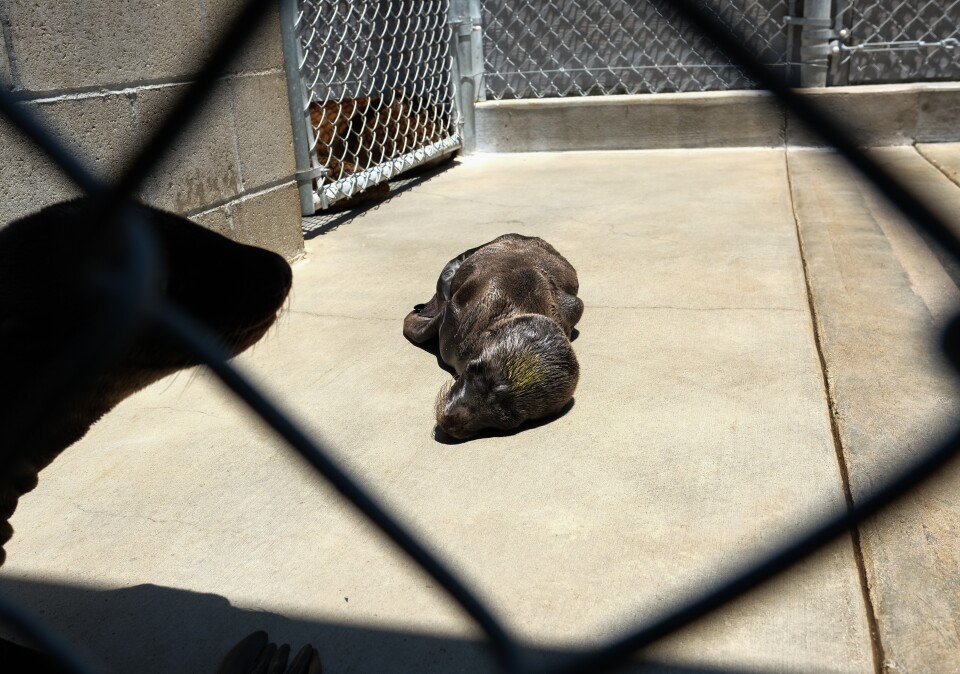Truth matters. Community matters. Your support makes both possible. LAist is one of the few places where news remains independent and free from political and corporate influence. Stand up for truth and for LAist. Make your tax-deductible donation now.
Toxic Algae Is Likely Sickening California's Sea Life. Here's What It Takes To Save A Poisoned Sea Lion

Hundreds of California sea lions, likely suffering from domoic acid toxicosis, have been flooding into animal treatment centers across Southern California over the past few weeks, believed to be the result of a toxic algal bloom off the coast of Southern California.
The Marine Mammal Care Center in San Pedro is one of the few facilities taking in the poisoned animals, and they’re so overwhelmed at this point that they’re regularly turning away dozens of sea lions that need treatment.

“We have over a hundred animals and we are definitely at or slightly above capacity,” said Lauren Palmer, the center’s veterinarian and hospital director. “We haven’t seen it here lately like this.”
If a sea lion is lucky enough to both survive poisoning and be transported to the care center, there’s a whole team waiting to try and help them recover.
Signs of domoic acid poisoning
Domoic acid ends up in the bodies of sea lions when they eat small fish, like sardines, that are filled with the toxic stuff. As the sea lion eats more and more of the fish, the poison builds up and wreaks havoc on their brains and hearts.
Death is a possibility, and so are a whole host of other symptoms including aggressive behavior, confusion, lethargy and frequent seizures.

The sea lions that are brought to the facility are assessed by medical staff and transported via squeeze cages, which helps protect the team treating them. They’re generally around 180-ish pounds, so this can be quite the task.
“There’s a better prognosis if you can intervene sooner with your treatments and your therapies,” said Palmer.
Those that are suffering from acute effects of the acid often refuse to eat and start to lose weight. If they’re pregnant, they can have miscarriages.
Walk by the cages of the sick animals and they’re just laying on the concrete floor or in play pools, disinterested in what’s going on around them.
Anticonvulsants, fish puree and rest
There’s no antidote for the poisoning, though the team treats seizures with anticonvulsants. Fluids and food are prioritized, with the center going through more than 800 pounds of Alaskan herring a day.
Animals on the mend are more likely to eat whole fish. Those that are struggling to recover and losing weight can be force fed via feeding tubes.


There are a couple of baby sea lions there, just a few weeks old. There are concerns that the domoic acid could be passed to them through their mom’s milk, so sometimes the team feeds them with formula instead.

For some sea lions, the dose of domoic acid is simply too high or intervention just came too late. They’ll continue to lose weight and have uncontrollable seizures. At a certain point, the team calls it and will euthanize the animal.
“Some days are great and you feel wonderful successes and other days are tough,” said Palmer. “I think we all try to rise to the occasion and address the need, but the longer it goes on the harder it gets.”
Ready to be released
A sea lion on the mend experiences fewer seizures, gains weight and is more energetic. Flopping up to the edge of their cages and barking at caretakers and reporters walking by with big microphones.

The center has yet to release any of the sea lions that’ve come in as a result of the recent algal bloom, but they are likely getting close. Hopefully it happens just in time to make space for more sea lions seeking treatment.

stranded marine mammals
If you see a stranded sea lion on the beach, don’t approach it. Call the West Coast Marine Mammal Stranding Network at (866) 767-6114.








